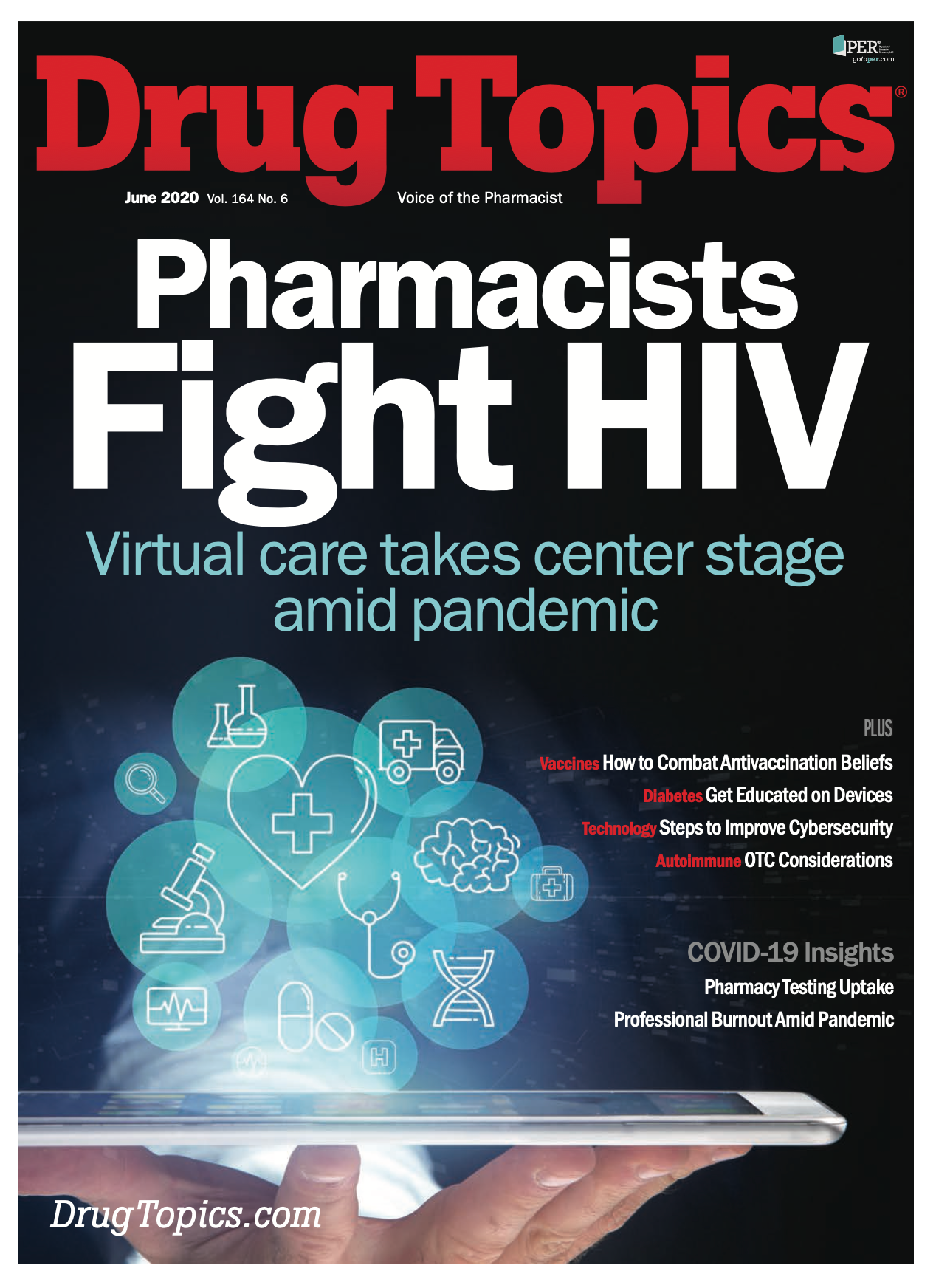Pharmacists Fight HIV
Virtual care takes center stage amid the pandemic.

In the wake of the novel coronavirus 2019 (COVID-19) pandemic, pharmacists face an ongoing challenge with helping patients optimally manage chronic conditions.
In HIV care, for example, pharmacists play a key role in monitoring treatments, counseling patients, and assisting with adherence challenges, all of which current social distancing measures can make more difficult. Furthermore, the potential effects of the COVID-19 virus on patients with HIV remain uncertain, even as reports indicate that other chronic conditions such as diabetes and hypertension may put affected individuals at higher risk.
“So far, there is no major report to suggest that HIV patients are more or less susceptible to COVID-19 than individuals who do not have HIV or are otherwise healthy,” Rodney Ho, PhD, professor of pharmaceutics at the University of Washington School of Pharmacy in Seattle, told Drug Topics®. “We don’t know why.”
According to a statement on Aidsinfo, a US Department of Health & Human Services website, the “limited data currently available do not indicate that the disease course of COVID-19 in persons with HIV differs from that of persons without HIV.” However, the website subsequently states that the use of effective antiretroviral therapy (ART) in the HIV population might be responsible for the current trend. Before the introduction of ART, a CD4 cell count below 200/mm3 was considered a risk factor for complications resulting from other respiratory infections. At press time, the website stated that whether HIV increases COVID-19 risk is still unknown. Until experts know for sure, the scientific consensus is that proactive measures to limit risk and exposure to COVID-19 should bear little difference to the measures taken by individuals who are generally healthy.
Preventative Moves During Pandemic
Health care systems have taken precautions to mitigate exposure and risk for patients with HIV. Perhaps the most significant change involves encouraging patients to stay home unless clinicians feel an office visit is medically necessary.
Clinicians are also taking proactive measures to prevent drug shortages and limit onsite visits. As a result, mail order use has surged. “We reach out to patients via phone around 5 to 10 days ahead of their next refill, so we can mail out their prescriptions to enhance adherence,” said a Houston, Texas–area HIV pharmacist who practices at an outpatient pharmacy located in a health center and wants to remain anonymous. “Sometimes we match the date with the patient’s next clinic visit and have their medications ready, making it easier for them to have access during the pandemic.”
In addition to enacting medication synchronization, the pharmacist’s organization now issues emergency fills and early refills to reduce or eliminate multiple trips to the pharmacy. Patients who pick up their prescriptions must maintain a 6-foot distance from other patients. The clinic also requires these patients to fill out a COVID-19 screening form that helps pharmacists determine who needs additional assistance or medical attention.
Telemedicine Takes Center Stage
Physical distandistancing in the HIV community has driven a massive uptick in telemedicine services. Many patient interactions, such as follow-up visits and education, now occur remotely. Although the industry trend indicates that most services for this patient population have gone remote, exceptions may apply with at-risk populations.
For example, providers at ChristianaCare’s William J. Holloway, MD, Community Program in Wilmington, Delaware, might require a site visit for patients who are older than 60 years or have certain disease states, such as lung disease and hypertension. “We are using virtual and telephonic visits, as well as preset algorithms for COVID,” said Kelly Cantwell-McNelis, PharmD, AAHIVP, a clinical pharmacy specialist with the community program.
In the outpatient pharmacy based in Houston, Texas, pharmacists make adherence calls to patients to monitor refills while screening them for signs and symptoms of the virus. “Since HIV patients are immunocompromised, we ask them if they are experiencing dry cough, fever, or chills currently, and document them in our pharmacy software,” the HIV pharmacist at the clinic said.
Phone calls and tracking prove critical because the clinic has a high number of patients with CD4 counts falling below 200 mm3, a sign of full-blown AIDS. These patients receive regular phone calls to monitor and address adherence, as well as to screen patients for opportunistic infections. Because of the pandemic, patients are now given the COVID-19 screening questionnaire over the phone.
Although telemedicine interventions have made operations more efficient, there have been hurdles. For instance, helping patients understand why they should call the pharmacy before making a trip has become a teaching opportunity that requires vigilance. “It took us a couple of weeks to get patients to understand that they should call us first and let us triage their symptoms,”said Cantwell-McNelis.
On the virtual front, Dan Scales, PharmD, AAHIVP, director of collaborative care pharmacy at Vivient Health and owner and founder of Scales Pharmacy in Denver, Colorado, and his colleagues have worked diligently to get up to speed on a new technological platform. He said that he thinks the process has gone generally well but recognizes that success also depends on the patient’s resources. Scales noted major obstacles with a patient living in a rural area. “We have to use video relay because the patient’s internet connection is not stable enough to hold a conversation in real time,” Scales said. Because the patient is deaf, interaction also requires a sign language interpreter.
Historically, the health care industry has wrestled with telemedicine navigating the nebulous web of integration and reimbursement. If there is any benefit from the pandemic, it is the swift action to establish and bill for telemedicine services, according to Cantwell-McNelis. She cited a recent New England Journal of Medicine article highlighting the near-overnight transition. “The speed of the transition has been dizzying. Changes that would typically encompass months of planning, pilot testing, and education have been compressed into days,” the authors wrote.
Post-pandemic Shifts in HIV Medicine
With no viable cure or treatment for COVID-19 yet, investigators are exploring the potential benefit of antiviral protease inhibitors (PIs) routinely used in HIV medicine. The findings’ effects on the HIV population continue to unfold with emerging data and research.
At press time, 15 studies exploring the effects of PIs on COVID-19 were found on ClinicalTrials.gov. Results from a randomized, controlled, open-label clinical trial on lopinavir-ritonavir (Kaletra) following 199 patients in China showed that the drug did not speed recovery or reduce the viral load in patients with COVID-19.
“Until we know more about how PIs affect COVID-19, people with HIV should not switch their HIV medicine in attempt to prevent or treat COVID- 19,” Scales warned.
Sources predict lasting changes in the post-COVID era of pharmacy. Scales and Cantwell-McNelis foresee telemedicine becoming a mainstay of treatment. Ho believes that the dynamics of the virus will further elevate the demand and profile of pharmacists’ contributions to the health care system by serving as a resource to the physician.
“Many physicians are emergency room doctors or heart specialists who are not trained in infectious diseases or to think about DDIs [drug-drug interactions] and how to monitor for heart conditions,” Ho said. “The pharmacist’s role is to serve as an expert when the physicians are caring for patients by looking for data to provide the best evidence available and being able to develop appropriate time-sensitive information.”
